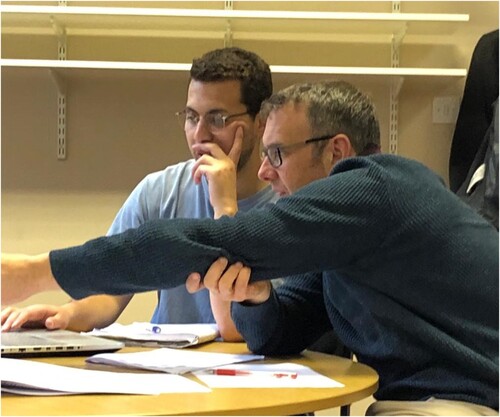Our dear friend and colleague Nicholas ‘Nick’ A. Besley died on 27th June 2021, aged 48, after falling from his bicycle and sustaining a catastrophic brain injury. He leaves behind his wife, Elena, and their daughter, Emily, his parents, and a brother, Adam. Elena (neé Bichoutskaia) and Nick married in 2007. They were our colleagues in the School of Chemistry at the University of Nottingham for many years, and Elena continues to be. Nick’s sudden death has taken from us an outstanding theoretical chemist at the height of his career, one which made significant contributions to a wide range of topics [Citation1–133]. We are honoured to remember Nick’s scientific achievements in this Special Issue.
Nick was born 23rd December, 1972, in Wickford, Essex, to Alan Besley, a draughtsman, and Dee (neé Wells), who worked in a bank. He grew up in Thundersley, Essex and attended local schools: Thundersley County Junior School, The Deanes School and South East Essex Sixth Form College.
Nick was the first in his extended family to go to university and graduated from the University of Sussex in 1994 with a first class BSc (Hons) in Chemical Physics. Two of the authors of this foreword (Peter and Tony) were academics in the School of Chemistry at Sussex when Nick embarked on his degree. Peter remembers meeting Nick in his first year at Sussex and the ease with which he sailed through challenging modules in pure mathematics that his predecessors on the degree had found much more difficult. Nick excelled at Sussex, winning the Chatt Prize and Molecular Sciences School Prize, and his undergraduate studies led to several published papers [Citation1–3]. The first was written with Tony McCaffery and co-workers and put forward a classical representation of dynamical angular momentum models for rotational transfer in polyatomic molecules [Citation1]. Nick’s undergraduate research also yielded a study on prediction of the stability of iron clusters [Citation2]. This 1995 paper described work with Tony Stace and the late Roy Johnston. Years later, Nick would again collaborate with Tony, publishing papers on helium nanodroplets in 2005 and 2015 [Citation24,Citation79], as colleagues at the University of Nottingham.
After his BSc, Nick stayed on at the University of Sussex to undertake a D. Phil. with Peter Knowles. During this period he re-located with Peter to the University of Birmingham and he continued his PhD there. Nick worked on two complementary projects. The first was a new piece of theory and software to extend accurate methods to larger molecules. The second focused on computing ab initio the potential energy surface of a prototypical reaction of a heavy atom with a heavy-light diatomic: Cl(2P)+ HCl → ClH + Cl(2P). The work was published [Citation5] by Nick and Peter in collaboration with Jonathan Connor (Manchester) and George Schatz (then at the Argonne National Laboratory).
In 1997, Nick moved to the sunny climes of southern California, taking a postdoctoral position at the Scripps Research Institute with Jonathan Hirst. In 2019, Nick in his inaugural lecture, marking his promotion to full professor, described with his distinctive sense of humour moving from a house with no central heating in Birmingham to a house with no central heating in San Diego, California! The physical climate of San Diego really suited Nick’s love of cycling, running and swimming. And the intellectual climate was one where he thrived. A rigorous training in quantum chemistry served Nick well, as he studied the theory of the electronic of amides and proteins [Citation4,Citation6–10]. This led to the development of what are still today the most accurate calculations of protein circular dichroism (CD) spectra [Citation8]. Nick continued to collaborate with Jonathan [Citation20,Citation25,Citation50,Citation83,Citation91] and to work in this area [Citation21,Citation31], but his contributions to computational spectroscopy were to become much broader.
Returning to the UK in 1999, Nick took a postdoctoral position with Peter Gill, who himself had just taken up a chair at the University of Nottingham (Figure ).
Figure 1 Left to right: Nick, Andrew Gilbert, Arantxa Sanz, Peter Gill and Jonathan Hirst shortly after Nick’s arrival at the University of Nottingham in 1999. Photograph courtesy of Mike George.
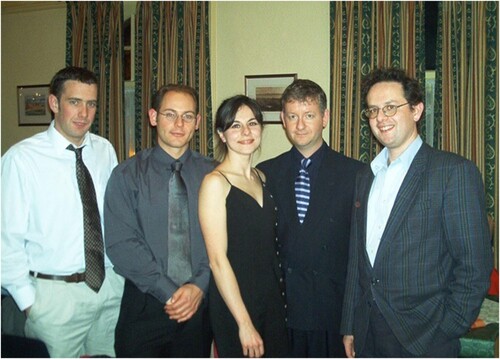
With Peter, Nick deepened his knowledge of quantum chemistry, developing the theory of intracules [Citation12,Citation14,Citation15,Citation17,Citation18]: two-electron functions that are well suited to studying inter-electronic interactions and the effects of electron correlation. The study of intracules [Citation23,Citation27,Citation30] was the basis for a prestigious 5-year EPSRC Advanced Research Fellowship, which Nick was awarded in 2002. He became a significant contributor to the quantum chemistry software suite, Q-Chem [Citation11,Citation29,Citation73,Citation132], notably the maximum overlap method (MOM) for self-consistent field calculations of excited states [Citation38], which arose from a sabbatical visit in 2007 with Peter Gill, who had moved to the Australian National University. The MOM helps maintain the target non-Aufbau orbital occupations and is a practical implementation of the so-called Δ-SCF method. It has found widespread utility, as reflected in several hundred citations of the paper. One of its more recent applications has been to ultrafast nonadiabatic dynamics [Citation120].
Around this time, Nick’s research horizons expanded further. He embarked on what was to become a particularly productive and long-standing collaboration with Nottingham colleague Mike George, centred on vibrational spectroscopy (Figure ).
Figure 2 Nick in the Nottingham sunshine, with long-standing collaborators Mike George (right) and Magnus Hanson-Heine (centre). Photograph courtesy of Mike George.
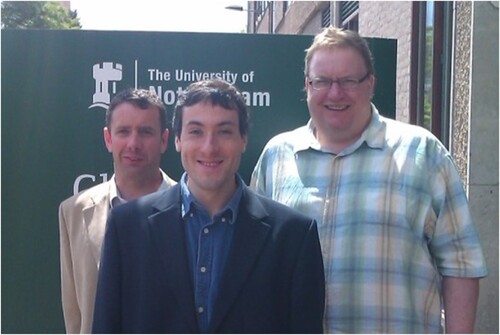
Their first paper was a time-resolved IR spectroscopic study of benzoyl radicals [Citation13]. They went on to work together with a jointly supervised PhD student (and subsequently postdoc), Magnus Hanson-Heine (Figure ), on calculating anharmonic frequencies [Citation55,Citation56], including for open-shell singlet excited states [Citation62,Citation78,Citation111] and excited triplet states [Citation102]. Nick, Magnus and Mike collaborated on many studies of systems of photochemical significance [Citation70,Citation92,Citation114] and on many types of spectroscopy, including non-resonant and resonant X-ray emission spectroscopy [Citation90,Citation97,Citation100]. They introduced a scaled CIS(D) based method for the calculation of valence and core electron ionization energies [Citation113].
Nick modelled molecules at surfaces [Citation16,Citation19,Citation22], developing collaborations with colleagues in Nottingham’s School of Physics and Astronomy [Citation16]. Interactions of molecules with nanotubes attracted Nick’s attention [Citation28,Citation36]. The need for computationally efficient routes to vibrational spectra of relatively large molecules prompted Nick to explore partial Hessian approaches [Citation32,Citation34,Citation35]. Analogously efficient approaches to the calculation of electronic excited states of large molecular systems was another area of interest. A scheme for focusing on a subset of single excitations localised on the solute molecule [Citation19] enabled calculations on fluorophores in complex molecular milieu, such as proteins and phospholipid membranes [Citation41,Citation43,Citation51,Citation52]. Nick also applied more established hybrid QM/MM methods to calculate the spectroscopy of molecules in water [Citation63]. Explicit representation of the solvent molecules was often important [Citation77]. The restricted excitation subspace approximation was developed further [Citation95], yielding additional computational savings.
Nick broke new ground in the computation of X-ray absorption [Citation33,Citation39,Citation40,Citation42,Citation86] and X-ray emission spectroscopy [Citation57,Citation72,Citation94,Citation119]. Much of this work was summarised in two recent reviews [Citation123,Citation129]. One of his important contributions for the former was the introduction of short-range corrected hybrid functionals in order to reduce the error in the computed core excitation energies [Citation44]. In this context, the incorporation of Hartree–Fock exchange at short range is beneficial [Citation67]. This technique was applied to many systems [Citation60], including, for example, proteins [Citation46,Citation48,Citation49] and surface-adsorbed molecules [Citation47]. He spoke on the topic of accurate calculations of the near edge X-ray absorption fine structure of large systems at ‘DFT 2013’, a conference held at Durham University (Figure ). An influential review of X-ray and electron spectroscopy to probe water was written with collaborators in 2016 [Citation85]. The local hydrogen-bond coordination in water influences specific features in its X-ray absorption and emission spectra [Citation98]. Nick developed a computationally efficient protocol for simulating resonant inelastic scattering maps [Citation99].
Figure 3 Nick presenting at the DFT 2013 conference held in Durham, United Kingdom. Photograph courtesy of David Tozer.
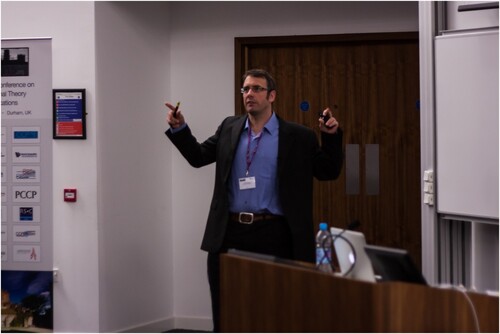
Nick’s early interest in nanotubes [Citation28,Citation36] developed into research on a range of nanoscience problems, often working with colleagues at Nottingham and collaborators further afield. Nick published seven papers with his wife, Elena [Citation45,Citation53,Citation74,Citation101,Citation107,Citation109,Citation130], several of which were in this field. Studies, usually with experimental collaborators, included the transformation of graphene to fullerene [Citation45], reactions of the inner surface of carbon nanotubes and nanoprotrusion processes [Citation53], and adsorption on hexagonal boron nitride [Citation81,Citation101,Citation107]. Nick explored the calculation of the vibrational frequencies of carbon clusters and fullerenes with empirical potentials [Citation75]. He developed a new empirical potential for this purpose [Citation89] with one of his PhD students, Pritesh Tailor (Figure ). Nick showed that the X-ray emission spectra of carbon nanotubes are weakly dependent on their length and chirality [Citation97]. The new empirical potential was extended to enable the calculation of Raman spectroscopy of multi-layered carbon nanomaterials [Citation108]. To model the physisorption of molecules on surfaces such as graphene and hexagonal boron nitride, Nick developed an approach, called AIRBED, where the constituent atoms of the surface are simply represented by a point charge to capture electrostatic effects [Citation115]. Recently, Nick presented a vibrational analysis of three types of carbon nanotube-based nanomechanical resonator [Citation124].
Figure 4 Nick at the 2018 graduation ceremony of PhD student, Pritesh Tailor. In the background are Andy Teale and James Furness. Photograph courtesy of Pritesh Tailor.
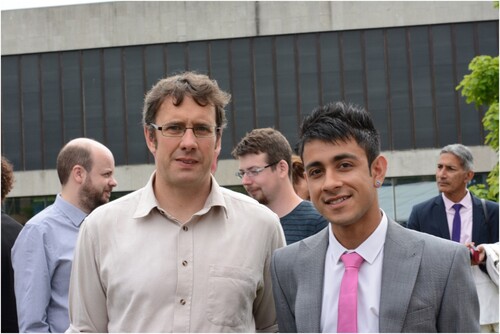
Nick computed the spectroscopy of a variety of dyes, e.g. BODIPY [Citation63,Citation83,Citation122], and biological systems, including blue copper proteins [Citation59,Citation66] and plastocyanin [Citation88]. He provided new insight into the NEXAFS, X-ray photoelectron and X-ray emission spectroscopy of ionic liquids [Citation93,Citation105,Citation116,Citation118]. Whilst much of Nick’s research sought to make calculations tractable on large systems, he had a strong interest in small prototypical systems, for example, studying the electronic states of nitric oxide and their interaction with rare gases [Citation54,Citation58,Citation64,Citation76,Citation96], in collaboration with his Nottingham colleague Tim Wright, and investigating other weakly bound systems [Citation69] and complexes [Citation106]. Nick calculated the X-ray emission spectroscopy of water [Citation57] and transition metal complexes [Citation84]. He examined the structure and stability of clusters of water and methanol [Citation61], ionized water clusters [Citation65], small radical cation clusters [Citation68,Citation71], and mixed carbon dioxide and fluorinated methane clusters [Citation80]. Work on helium nanodroplets was pursued with Tony Stace [Citation24,Citation79] and later with Andy Ellis at Leicester [Citation87], including studies of cold helium-tagged cations [Citation110,Citation117] and dimers of acetic acid inside liquid helium nanodroplets [Citation112]. In collaboration with another Nottingham colleague, Ivan Powis, Nick provided calculations supporting experimental investigations of Auger electron spectra following excitation or ionization for methyl iodide [Citation103,Citation104,Citation121,Citation125].
The diversity of Nick’s most recent work reflects his wide range of interests. Nick and PhD student, Adam Fouda (Figure ), investigated the nitrogen K-edge resonant inelastic X-ray scattering map of nitric oxide [Citation126]. Alexandra Foerster, another of Nick’s PhD students, has been working on the X-ray emission spectroscopy of amino acids and proteins [Citation127] and very recently on the quantum chemical characterization and design of quantum dots [Citation133]. Other work focused on the vibrationally resolved absorption spectra of neutral and cationic polyaromatic hydrocarbons [Citation128] and on density functional theory calculations of carbon dioxide adsorption on MoS2 surfaces [Citation130]. Nick was continuing to develop new functionals to calculate core-electron binding energies at the K-edge of heavier elements [Citation131].
It was our privilege to witness Nick’s successes over his career. Nick was an outstanding teacher, receiving a School of Chemistry Teaching Excellence Award in 2018, the same year that he was promoted to full professor. The excellence of his research was recognized by The Molecular Graphics and Modelling Society with the presentation of its first Silver Jubilee Prize in 2007 and the Leverhulme Trust awarded Nick a Research Fellowship in 2014. He was also active in the broader scientific community, establishing the RSC Theoretical Chemistry Group international conference series. Academic research, in contrast to many other professions, leaves an enduring legacy. Nick’s contributions to science will be read and used by researchers for many years to come. Nick’s friends and colleagues in the School of Chemistry and the University of Nottingham and the wider academic community will remember Nick as a true scholar and as a wonderful human being.
Disclosure statement
No potential conflict of interest was reported by the author(s).
Correction Statement
This foreword has been corrected with minor changes. These changes do not impact the academic content of the foreword.
References
- Z.T. Alwahabi, N.A. Besley, A.J. McCaffery, M.A. Osborne and Z. Rawi. J. Chem. Phys. 102, 7945–7952 (1995). doi:10.1063/1.468993.
- N.A. Besley, R.L. Johnston, A.J. Stace and J. Uppenbrink. J. Mol. Structure - Theochem. 341, 75–90 (1995). doi:10.1016/0166-1280(95)04207-M.
- N.A. Besley, A.J. McCaffery, M.A. Osborne and Z. Rawi. J. Phys. B: At. Mol. Opt. Phys. 31, 4267–4282 (1998). doi:10.1088/0953-4075/31/19/014.
- N.A. Besley and J.D. Hirst. J. Phys. Chem. A. 102, 10791–10797 (1998). doi:10.1021/jp982645f.
- A.J. Dobbyn, J.N.L. Connor, N.A. Besley, P.J. Knowles and G.C. Schatz. Phys. Chem. Chem. Phys. 1, 957–966 (1999). doi:10.1039/a808183b.
- J.D. Hirst and N.A. Besley. J. Chem. Phys. 111, 2846–2847 (1999). doi:10.1063/1.479563.
- N.A. Besley and J.D. Hirst. J. Am. Chem. Soc. 121, 8559–8566 (1999). doi:10.1021/ja990064d.
- N.A. Besley and J.D. Hirst. J. Am. Chem. Soc. 121, 9636–9644 (1999). doi:10.1021/ja990627l.
- N.A. Besley and J.D. Hirst. J. Mol. Structure - Theochem. 506, 161–167 (2000). doi:10.1016/S0166-1280(00)00409-7.
- N.A. Besley, M.-J. Brienne and J.D. Hirst. J. Phys. Chem. B. 104, 12371–12377 (2000). doi:10.1021/jp0024524.
- J. Kong, C.A. White, A.I. Krylov, C.D. Sherrill, R.D. Adamson, T.R. Furlani, M.S. Lee, A.M. Lee, S.R. Gwaltney, T.R. Adams, H. Daschel, W. Zhang, C. Ochsenfeld, A.T.B. Gilbert, G. Kedziora, D.R. Maurice, N. Nair, Y. Shao, N.A. Besley, P.E. Maslen, J.P. Dombroski, J. Baker, E.F.C. Byrd, T. Van Voorhis, M. Oumi, S. Hirata, C.-P. Hsu, N. Ishikawa, J. Florian, A. Warshel, B.G. Johnson, P.M.W. Gill, M. Head-Gordon and J.A. Pople. J. Comput. Chem. 21, 1532–1548 (2000). doi:10.1002/1096-987X(200012)21:16<1532::AID-JCC10>3.0.CO;2-W.
- N.A. Besley, A.M. Lee and P.M.W. Gill. Mol. Phys. 100, 1763–1770 (2002). doi:10.1080/00268970110111779.
- C.S. Colley, D.C. Grills, N.A. Besley, S. Jockusch, P. Matousek, A.W. Parker, M. Towrie, N.J. Turro, P.M.W. Gill and M.W. George. J. Am. Chem. Soc. 124, 14952–14958 (2002). doi:10.1021/ja026099m.
- P.M.W. Gill, D.P. O'Neill and N.A. Besley. Theor. Chem. Acc. 109, 241–250 (2003). doi:10.1007/s00214-002-0411-5.
- N.A. Besley, D.P. O'Neill and P.M.W. Gill. J. Chem. Phys. 118, 2033–2038 (2003). doi:10.1063/1.1532311.
- M.A. Phillips, N.A. Besley, P.M.W. Gill and P. Moriarty. Phys. Rev. B. 67, 35309 (2003). doi:10.1103/PhysRevB.67.035309.
- P.M.W. Gill, N.A. Besley and D.P. O'Neill. Int. J. Quantum Chem. 100, 166–171 (2004). doi:10.1002/qua.20125.
- N.A. Besley and P.M.W. Gill. J. Chem. Phys. 120, 7290–7297 (2004). doi:10.1063/1.1690233.
- N.A. Besley. Chem. Phys. Lett. 190, 124–129 (2004). doi:10.1016/j.cplett.2004.04.004.
- N.A. Besley, M.T. Oakley, A.J. Cowan and J.D. Hirst. J. Am. Chem. Soc. 126, 13502–13511 (2004). doi:10.1021/ja047603l.
- N.A. Besley. J. Phys. Chem. A. 108, 10794–10800 (2004). doi:10.1021/jp046073c.
- N.A. Besley. J. Chem. Phys. 122, 184706 (2005). doi:10.1063/1.1891687.
- N.A. Besley. Chem. Phys. Lett. 409, 63–69 (2005). doi:10.1016/j.cplett.2005.04.095.
- A. Boatwright, N.A. Besley, S. Curtis, R.R. Wright and A.J. Stace. J. Chem. Phys. 123, 21102 (2005). doi:10.1063/1.1988309.
- D.M. Rogers, N.A. Besley, P. O'Shea and J.D. Hirst. J. Phys. Chem. B. 109, 23061–23069 (2005). doi:10.1021/jp053309j.
- N.A. Besley, J.J. Titman and M.D. Wright. J. Am. Chem. Soc. 127, 17948–17953 (2005). doi:10.1021/ja055888b.
- P.M.W. Gill, D. Crittenden, D.P. O'Neill and N.A. Besley. Phys. Chem. Chem. Phys. 8, 15–25 (2006). doi:10.1039/b511472a.
- N.A. Besley and A.J. Blundy. J. Phys. Chem. B. 110, 1701–1710 (2006). doi:10.1021/jp055191c.
- Y. Shao, L. Fusti-Molnar, Y. Jung, J. Kussman, C. Ochsenfeld, S.T. Brown, A.T.B. Gilbert, L.V. Slipchenko, S.V. Levchenko, D.P. O'Neill, R.A. Distasio, Jr, R.C. Lochan, T. Wang, G.J.O. Beran, N.A. Besley, J.M. Herbert, Y.L. Lin, T. Van Voorhis, S.H. Chien, A. Sodt, R.P. Steele, V.A. Rassolov, P.E. Maslen, P.P. Korambath, R.D. Adamson, B. Austin, J. Baker, E.F.C. Byrd, H. Daschle, R.J. Doerksen, A. Dreuw, B.D. Dunietz, A.D. Dutoi, T.R. Furlani, S.R. Gwaltney, A. Heyden, S. Hirata, C.-P. Hsu, G. Kedziora, R.Z. Khalliulin, P. Klunzinger, A.M. Lee, M.S. Lee, W. Lian, I. Lotan, N. Nair, B. Peters, E.I. Proynov, P.A. Pieniazek, Y.M. Rhee, J. Ritchie, E. Rosta, C.D. Sherrill, A.C. Simmonett, J.E. Subotnik, H.L. Woodcock, III, W. Zhang, A.T. Bell, A.K. Chakraborty, D.M. Chipman, W.J. Hehre, A. Warshel, H.F. Schaefer, III, J. Kong, A.I. Krilov, P.M.W. Gill and M. Head-Gordon. Phys. Chem. Chem. Phys. 8, 3172–3191 (2006). doi:10.1039/b517914a
- N.A. Besley. J. Chem. Phys. 125, 074104 (2006). doi:10.1063/1.2244561.
- N.A. Besley and N.L. Doltsinis. J. Chem. Theory Comput. 2, 1598–1604 (2006). doi:10.1021/ct600244z.
- N.A. Besley and K.A. Metcalf. J. Chem. Phys. 126, 035101 (2007). doi:10.1063/1.2426344.
- N.A. Besley and A. Noble. J. Phys. Chem. C. 111, 3333–3400 (2007). doi:10.1021/jp065160x.
- N.A. Besley. Phil. Trans. A (Triennial Edition). 365, 2799–2812 (2007). doi:10.1098/rsta.2007.0018.
- N.A. Besley and J. Bryan. J. Phys. Chem. C. 112, 4308–4314 (2008). doi:10.1021/jp076167x.
- N.A. Besley and A. Noble. J. Chem. Phys. 128, 101102 (2008). doi:10.1063/1.2894538.
- F.A. Asmuruf and N.A. Besley. J. Chem. Phys. 129, 064705 (2008). doi:10.1063/1.2967190.
- A.T.B. Gilbert, N.A. Besley and P.M.W. Gill. J. Phys. Chem. A. 112, 13164–13171 (2008). doi:10.1021/jp801738f.
- F.A. Asmuruf and N.A. Besley. Chem. Phys. Lett. 463, 267–271 (2008). doi:10.1016/j.cplett.2008.08.054.
- F.A. Asmuruf and N.A. Besley. Surf. Sci. 603, 158–164 (2009). doi:10.1016/j.susc.2008.10.043.
- D. Robinson, N.A. Besley, E. Lunt, P. O'Shea and J.D. Hirst. J. Phys. Chem. B. 113, 2535–2541 (2009). doi:10.1021/jp808943d.
- N.A. Besley, A.T.B. Gilbert and P.M.W. Gill. J. Chem. Phys. 130, 124308 (2009). doi:10.1063/1.3092928.
- D. Robinson, N.A. Besley, P. O'Shea and J.D. Hirst. J. Phys. Chem. B. 113, 14521–14528 (2009). doi:10.1021/jp9071108.
- N.A. Besley, M.J.G. Peach and D.J. Tozer. Phys. Chem. Chem. Phys. 11, 10350–10358 (2009). doi:10.1039/b912718f.
- A. Chuvilin, U. Kaiser, E. Bichoutskaia, N.A. Besley and A.N. Khlobystov. Nat. Chem. 2, 450–453 (2010). doi:10.1038/NCHEM.644.
- D. Robinson and N.A. Besley. Phys. Chem. Chem. Phys. 12, 9667–9676 (2010). doi:10.1039/c001805h.
- N.A. Besley and F.A. Asmuruf. Phys. Chem. Chem. Phys. 12, 12024–12039 (2010). doi:10.1039/c002207a.
- N.A. Besley and D. Robinson. Faraday Discuss. 148, 55–70 (2011). doi:10.1039/c004231e.
- M.W. Buckley and N.A. Besley. Chem. Phys. Lett. 501, 540–546 (2011). doi:10.1016/j.cplett.2010.12.004.
- M.-P. Gaigeot, N.A. Besley and J.D. Hirst. J. Phys. Chem. B. 115, 5526–5535 (2011). doi:10.1021/jp111140f.
- D. Robinson, N.A. Besley, P. O'Shea and J.D. Hirst. J. Phys. Chem. B. 115, 4160–4167 (2011). doi:10.1021/jp1111372.
- D. Robinson, N.A. Besley, P. O'Shea and J.D. Hirst. J. Comp. Chem. 32, 2613–2618 (2011). doi:10.1002/jcc.21840.
- T.W. Chamberlain, J.C. Meyer, J. Biskupek, J. Leschner, A. Santana, N.A. Besley, E. Bichoutskaia, U. Kaiser and A.N. Khlobystov. Nat. Chem. 3, 732–737 (2011). doi:10.1038/NCHEM.1115.
- O.V. Ershova and N.A. Besley. Chem. Phys. Lett. 513, 179–183 (2011). doi:10.1016/j.cplett.2011.07.089.
- M.W.D. Hanson-Heine, M.W. George and N.A. Besley. J. Phys. Chem. A. 116, 4417–4425 (2012). doi:10.1021/jp301670f.
- M.W.D. Hanson-Heine, M.W. George and N.A. Besley. J. Chem. Phys. 136, 224102 (2012). doi:10.1063/1.4727853.
- N.A. Besley. Chem. Phys. Lett. 542, 42–46 (2012). doi:10.1016/j.cplett.2012.05.059.
- O.V. Ershova and N.A. Besley. J. Chem. Phys. 136, 244313 (2012). doi:10.1063/1.4730302.
- H. Do and N.A. Besley. J. Phys. Chem. A. 116, 8507–8514 (2012). doi:10.1021/jp305807z.
- S.T. Skowron and N.A. Besley. Theor. Chem. Acc. 131, 1267 (2012). doi:10.1007/s00214-012-1267-y.
- H. Do and N.A. Besley. J. Chem. Phys. 137, 134106 (2012). doi:10.1063/1.4755994.
- M.W.D. Hanson-Heine, M.W. George and N.A. Besley. J. Chem. Phys. 138, 064101 (2013). doi:10.1063/1.4789813.
- E.A. Briggs, N.A. Besley and D. Robinson. J. Phys. Chem. A. 117, 2644–2650 (2013). doi:10.1021/jp312229b.
- O.V. Ershova, J. Klos, J.P. Harris, A.M. Gardner, V. Tame-Reyes, A. Andrejeva, M.H. Alexander, N.A. Besley and T.G. Wright. J. Chem. Phys. 138, 214313 (2013). doi:10.1063/1.4808027.
- H. Do and N.A. Besley. J. Phys. Chem. A. 117, 5385–5391 (2013). doi:10.1021/jp405052g.
- H. Do, R.J. Deeth and N.A. Besley. J. Phys. Chem. B. 117, 8105–8112 (2013). doi:10.1021/jp404107j.
- G. Capano, T.J. Penfold, N.A. Besley, C.J. Milne, M. Reinhard, H. Rittmann-Frank, P. Glatzel, R. Abela, U. Rothlisberger, M. Chergui and I. Tavernelli. Chem. Phys. Lett. 580, 179–184 (2013). doi:10.1016/j.cplett.2013.06.060.
- H. Do and N.A. Besley. Phys. Chem. Chem. Phys. 15, 16214–16219 (2013). doi:10.1039/c3cp52922c.
- E.A. Briggs and N.A. Besley. Phys. Chem. Chem. Phys. 16, 14455–14462 (2014). doi:10.1039/c3cp55361b.
- P.A. Summers, J. Dawson, F. Ghiotto, M.W.D. Hanson-Heine, K.Q. Vuong, S. Davies, X.-Z. Sun, N.A. Besley, J. McMaster, M.W. George and M. Schroder. Inorg. Chem. 53, 4430–4439 (2014). doi:10.1021/ic500089b.
- J.D. Wadey and N.A. Besley. Chem. Phys. Lett. 601, 110–115 (2014). doi: 10.1016/j.cplett.2014.03.081.
- J.D. Wadey, N.A. Besley and J. Chem. Theory and Comput. 10, 4557–4564 (2014). doi: 10.1021/ct500566k.
- Y. Shao, Z. Gan, E. Epifanovsky, A.T.B. Gilbert, M. Wormit, J. Kussmann, A.W. Lange, A. Behn, J. Deng, X. Feng, D. Ghosh, M. Goldey, P.R. Horn, L.D. Jacobson, I. Kaliman, R.Z. Khaliullin, T. Ku, A. Landau, J. Liu, E.I. Proynov, Y.M. Rhee, R.M. Richard, M.A. Rohrdanz, R.P. Steele, E.J. Sundstrom, H.L.W.I.I.I. P, M. Zimmerman, D. Zuev, B. Albrecht, E. Alguire, B. Austin, G.J.O. Beran, Y.A. Bernard, E. Berquist, K. Brandhorst, K.B. Bravaya, S.T. Brown, D. Casanova, C.-M. Chang, Y. Chen, S.H. Chien, K.D. Closser, D.L. Crittenden, M. Diedenhofen, R.A.D. Jr, H. Do, A.D. Dutoi, R.G. Edgar, S. Fatehi, L. Fusti-Molnar, A. Ghysels, A. Golubeva-Zadorozhnaya, J. Gomes, M.W. Hanson-Heine, P.H. Harbach, A.W. Hauser, E.G. Hohenstein, Z.C. Holden, T.-C. Jagau, H. Ji, B. Kaduk, K. Khistyaev, J. Kim, J. Kim, R.A. King, P. Klunzinger, D. Kosenkov, T. Kowalczyk, C.M. Krauter, K.U. Lao, A.D. Laurent, K.V. Lawler, S.V. Levchenko, C.Y. Lin, F. Liu, E. Livshits, R.C. Lochan, A. Luenser, P. Manohar, S.F. Manzer, S.-P. Mao, N. Mardirossian, A.V. Marenich, S.A. Maurer, N.J. Mayhall, E. Neuscamman, C.M. Oana, R. Olivares-Amaya, D.P. ONeill, J.A. Parkhill, T.M. Perrine, R. Peverati, A. Prociuk, D.R. Rehn, E. Rosta, N.J. Russ, S.M. Sharada, S. Sharma, D.W. Small, A. Sodt, et al. Mol. Phys. 113, 184–215 (2015). doi:10.1080/00268976.2014.952696.
- A.I. Solomatina, D.V. Krupenya, V.V. Gurzhii, I. Zlatkin, A.P. Pushkarev, M.N. Bochkarev, N.A. Besley, E. Bichoutskaia and S.P. Tunik. Dalton Trans. 44, 7152–7162 (2015). doi:10.1039/c4dt03106g.
- H. Do and N.A. Besley. Phys. Chem. Chem. Phys. 17, 3898–3903 (2015). doi:10.1039/c4cp05424e.
- O.V. Ershova, J. Klos, N.A. Besley and T.G. Wright. J. Chem. Phys. 142, 034311 (2015). doi:10.1063/1.4905563.
- E.A. Briggs and N.A. Besley. J. Phys. Chem. A. 119, 2902–2907 (2015). doi:10.1021/acs.jpca.5b01124.
- M.W.D. Hanson-Heine, A. Wriglesworth, M. Uroos, J.A. Calladine, T.S. Murphy, M. Hamilton, I.P. Clark, M. Towrie, J. Dowden, N.A. Besley and M.W. George. J. Chem. Phys. 142, 154119 (2015). doi:10.1063/1.4917311.
- J. Jeffs, N.A. Besley, A.J. Stace, G. Sarma, E.M. Cunningham, A. Boatwright, S. Yang and A.M. Ellis. Phys. Rev. Lett. 114, 233401 (2015). doi:10.1103/PhysRevLett.114.233401.
- M.W.D. Hanson-Heine and N.A. Besley. Chem. Phys. Lett. 638, 191–195 (2015). doi:10.1016/j.cplett.2015.08.056.
- V.V. Korolkov, S.A. Svatek, A. Summerfield, J. Kerfoot, L. Yang, T. Taniguchi, K. Watanabe, N.R. Champness, N.A. Besley and P.H. Beton. ACS Nano. 9, 10347–10355 (2015). doi:10.1021/acsnano.5b04443.
- L. Jiao, C. Yu, J. Wang, E.A. Briggs, N.A. Besley, D. Robinson, M.J. Ruedas-Rama, A. Orte, L. Crovetto, E.M. Talavera, J.M. Alvarez-Pez, M. Van der Auweraer and N. Boens. RSC Adv. 8, 89375 (2015). doi:10.1039/c5ra17419h.
- M.W.D. Hanson-Heine, F. Husseini, J.D. Hirst and N.A. Besley. J. Chem. Theory and Comput. 12, 1905–1918 (2016). doi:10.1021/acs.jctc.5b01198.
- I.P.E. Roper and N.A. Besley. J. Chem. Phys. 144, 114104 (2016). doi:10.1063/1.4943862.
- T. Fransson, Y. Harada, N. Kosugi, N.A. Besley, B. Winter, L.G.M. Pettersson and A. Nilsson. Chem. Rev. 116, 7551–7569 (2016). doi:10.1021/acs.chemrev.5b00672.
- N.A. Besley. J. Chem. Theory and Comput. 12, 5018–5025 (2016). doi:10.1021/acs.jctc.6b00656.
- A. Sadoon, G. Sarma, E.M. Cunningham, J. Tandy, M.W.D. Hanson-Heine, N.A. Besley, S. Yang and A.M. Ellis. J. Phys. Chem. A, 8085–8092 (2016). doi:10.1021/acs.jpca.6b06227.
- C.A. Hurd, N.A. Besley and D. Robinson. J. Comput. Chem. 38, 1431–1437 (2017). doi:10.1002/jcc.24666.
- P.M. Tailor, R.J. Wheatley and N.A. Besley. Carbon. N. Y. 113, 299–308 (2017). doi:10.1016/j.carbon.2016.11.059.
- M.W.D. Hanson-Heine, M.W. George and N.A. Besley. J. Chem. Phys. 146, 094106 (2017). doi:10.1063/1.4977178.
- C.J. Seuss, J.D. Hirst and N.A. Besley. J. Comp. Chem. 38, 1495–1502 (2017). doi:10.1002/jcc.24793.
- M. Reinhard, G. Auböck, N.A. Besley, I.P. Clark, G.M. Greetham, M.W.D. Hanson-Heine, R. Horvath, T.S. Murphy, T.J. Penfold, M. Towrie, M.W. George and M. Chergui. J. Am. Chem. Soc. 139, 7335–7347 (2017). doi:10.1021/jacs.7b02769.
- R.M. Fogarty, R.P. Matthews, M.T. Clough, C.R. Ashworth, A. Brandt-Talbot, P.J. Corbett, R.G. Palgrave, R.A. Bourne, T.W. Chamberlain, T. Vander Hoogerstraete, P.B.J. Thompson, P.A. Hunt, N.A. Besley and K.R.J. Lovelock. Phys. Chem. Chem. Phys. 19, 31156–31167 (2017). doi:10.1039/c7cp07143d.
- A.E.A. Fouda and N.A. Besley, Theor. Chem. Acc. 137, 6 (2017). doi:10.1007/s00214-017-2181-0.
- M.W.D. Hanson-Heine, M.W. George and N.A. Besley. Mol. Phys. 116, 1452–1459 (2018). doi:10.1080/00268976.2018.1430388.
- K.A. Linton, T.G. Wright and N.A. Besley. Phil. Trans. Roy. Soc. A. 376, 20170152 (2018). doi:10.1098/rsta.2017.0152.
- M.W.D. Hanson-Heine, M.W. George and N.A. Besley. Chem. Phys. Lett. 696, 119–124 (2018). doi:10.1016/j.cplett.2018.02.028.
- I. Zhovtobriukh, N.A. Besley, T. Fransson, A. Nilsson and L.G.M. Pettersson. J. Chem. Phys. 148, 144507. doi:10.1063/1.5009457.
- A.E.A. Fouda, G.I. Purnell and N.A. Besley. J. Chem. Theor. Comput. 14, 2586–2595 (2018). doi:10.1021/acs.jctc.8b00211.
- M.W.D. Hanson-Heine, M.W. George and N.A. Besley. Chem. Phys. Lett. 699, 279–285 (2018). doi:10.1016/j.cplett.2018.03.066.
- J. Kerfoot, V.V. Korolkov, A.S. Nizovtsev, R. Jones, T. Taniguchi, K. Watanabe, I. Lesanovsky, B. Olmos, N.A. Besley, E. Besley and P.H. Beton. J. Chem. Phys. 149, 054701 (2018). doi:10.1063/1.5041418.
- M.W.D. Hanson-Heine, J.A. Calladine, J. Yang, M. Towrie, R. Horvath, N.A. Besley and M.W. George. Chem. Phys. 512, 44–52 (2018). doi:10.1016/j.chemphys.2018.04.014.
- R. Forbes, A. De Fanis, C. Bomme, D. Rolles, S.T. Pratt, I. Powis, N.A. Besley, S. Nandi, A.R. Milosavljevic, C. Nicolas, J.D. Bozek, J.G. Underwood and D.M.P. Holland. J. Chem. Phys. 149, 094304 (2018). doi:10.1063/1.5045640.
- R. Forbes, A. De Fanis, C. Bomme, D. Rolles, S.T. Pratt, I. Powis, N.A. Besley, M. Simon, S. Nandi, A.R. Milosavljevic, C. Nicolas, J.D. Bozek, J.G. Underwood and D.M.P. Holland. J. Chem. Phys. 149, 144302. doi:10.1063/1.5035496.
- A.R. Santos, M.W.D. Hanson-Heine, N.A. Besley and P. Licence. Chem. Commun. 54, 11403–11406 (2018). doi:10.1039/c8cc05515g.
- S. Sharma, T.G. Wright and N.A. Besley. Phys. Chem. Chem. Phys. 20, 25931–25938 (2018). doi:10.1039/c8cp05681a.
- M. Alkhamisi, V.V. Korolkov, A.S. Nizovtsev, J. Kerfoot, T. Taniguchi, K. Watanabe, N.A. Besley, E. Besley and P.H. Beton. Chem. Commun. 54, 12021–12024 (2018). doi:10.1039/c8cc06304d.
- P.M. Tailor, R.J. Wheatley and N.A. Besley. Phys. Chem. Chem. Phys. 20, 28001–28010 (2018). doi:10.1039/c8cp05908j.
- L.X. Yang, P. Langer, S.E. Davies, M. Baldoni, K. Wickham, N.A. Besley, E. Besley and N.R. Champness. Chem. Sci. 10, 3723–3732 (2019). doi:10.1039/c9sc00167k.
- J.A. Davies, N.A. Besley, S.F. Yang and A.M. Ellis. J. Phys. Chem. Lett. 10, 2108–2112 (2019). doi:10.1021/acs.jpclett.9b00767.
- M.W.D. Hanson-Heine, M.W. George and N.A. Besley. Chem. Phys. Lett. 726, 62–68 (2019). doi:10.1016/j.cplett.2019.04.038.
- J.A. Davies, M.W.D. Hanson-Heine, N.A. Besley, A. Shirley, J. Trowers, S.F. Yang and A.M. Ellis. Phys. Chem. Chem. Phys. 21, 13950–13958 (2019). doi:10.1039/c8cp05934a.
- M.W.D. Hanson-Heine, M.W. George and N.A. Besley. J. Chem. Phys. 151, 034104 (2019). doi:10.1063/1.5100098.
- S.A. Bartlett, N.A. Besley, A.J. Dent, S. Diaz-Moreno, J. Evans, M.L. Hamilton, M.W.D. Hanson-Heine, R. Horvath, V. Manici, X.Z. Sun, M. Towrie, L.J. Wu, X.Y. Zhang and M.W. George. J. Am. Chem. Soc. 141, 11471–11480 (2019). doi:10.1021/jacs.8b13848.
- S.E. Mason, P.H. Beton and N.A. Besley. J. Chem. Theor. Comput. 15, 5628–5634 (2019). doi:10.1021/acs.jctc.9b00576.
- C.J. Clarke, S. Hayama, A. Hawes, J.P. Hallett, T.W. Chamberlain, K.R.J. Lovelock and N.A. Besley. J. Phys. Chem. A. 123, 9552–9559 (2019). doi:10.1021/acs.jpca.9b08037.
- J.A. Davies, N.A. Besley, S.F. Yang and A.M. Ellis. J. Chem. Phys. 151, 194307 (2019). doi:10.1063/1.5124137.
- E.J. Dick, A.E.A. Fouda, N.A. Besley and P. Licence. Phys. Chem. Chem. Phys. 22, 1624–1631 (2020). doi:10.1039/c9cp01297d.
- A.E.A. Fouda and N.A. Besley. J. Comput. Chem. 41, 1081–1090 (2020). doi:10.1002/jcc.26153.
- T. Northey, J. Norell, A.E.A. Fouda, N.A. Besley, M. Odelius and T.J. Penfold. Phys. Chem. Chem. Phys. 22, 2667–2676 (2020). doi:10.1039/c9cp03019k.
- R. Forbes, S.T. Pratt, A. De Fanis, A.R. Milosavljevic, C. Nicolas, J.D. Bozek, N.A. Besley and D.M.P. Holland. Phys. Rev. A. 101, 023408. doi:10.1103/PhysRevA.101.023408.
- B. Mangham, M.W.D. Hanson-Heine, E.S. Davies, A. Wriglesworth, M.W. George, W. Lewis, D.L. Kays, J. McMaster, N.A. Besley and N.R. Champness. Phys. Chem. Chem. Phys. 22, 4429–4438 (2020). doi:10.1039/c9cp06427c.
- N.A. Besley. Acc. Chem. Res. 53, 1306–1315 (2020). doi:10.1021/acs.accounts.0c00171.
- N.A. Besley. J. Phys. Chem. C. 124, 16714–16721 (2020). doi:10.1021/acs.jpcc.0c04998.
- R. Forbes, A. De Fanis, D. Rolles, S.T. Pratt, I. Powis, N.A. Besley, A.R. Milosavljevic, C. Nicolas, J.D. Bozek and D.M.P. Holland. J. Phys. B – At. Mol. Opt. Phys. 53, 155101 (2020). doi:10.1088/1361-6455/ab8c5a.
- A.E.A. Fouda, L.C. Seitz, D. Hauschild, M. Blum, W.L. Yang, C. Heske, L. Weinhardt and N.A. Besley. J. Phys. Chem. Lett. 11, 7476–7482 (2020). doi:10.1021/acs.jpclett.0c01981.
- A. Foerster and N.A. Besley. Chem. Phys. Lett. 757, 137860 (2020). doi:10.1016/j.cplett.2020.137860.
- R.J. Chadwick, K. Wickham and N.A. Besley. Theor. Chem. Acc. 139, 185 (2020). doi:10.1007/s00214-020-02697-7.
- N.A. Besley. WIReS. 11, e1527 (2021). doi:10.1002/wcms.1527.
- F.M. Enujekwu, Y. Zhang, C.I. Ezeh, H.T. Zhao, M.X. Xu, E. Besley, M.W. George, N.A. Besley, H. Do and T. Wu. Appl. Surf. Sci. 542, 148556 (2021). doi:10.1016/j.apsusc.2020.148556.
- N.A. Besley. J. Chem. Theor. Comput. 17, 3644–3651 (2021). doi:10.1021/acs.jctc.1c00171.
- E. Epifanovsky, et al. J. Chem. Phys. 155, 084801 (2021). doi:10.1063/5.0055522.
- A. Foerster and N.A. Besley. J. Phys. Chem. A. 126, 2899–2908 (2022). doi:10.1021/acs.jpca.2c00947.

